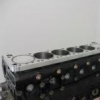Water Pump Flow Rates
Announcements
-
Similar Content
-
Latest Posts
-
By joshuaho96 · Posted
From the pictures I have when doing the job the flywheel is the same diameter, I don't think they're playing weird tricks like putting weights at the outer diameter to increase flywheel inertia or anything like that. The OEM flywheel is definitely heavier, but it's not a huge difference. Quoted weight savings of the clutch is 2 kg so I can't imagine the flywheel being lighter than ~7 kg. Kind of regret not weighing it before the clutch went into the car but as far as driveability goes I have no complaints. -
By joshuaho96 · Posted
HKS trigger kit should be very easy to integrate with a Link. It's a 36-2 crank trigger. Hard part is finding the motivation to take off the timing belt and everything on the front of the engine to install it. You also need to cut out a hole in the oil pump housing so the sensor can read the trigger wheel. Changing out the cam sensor for a 24 tooth setup is probably good enough but as others have mentioned depending on what underlying assumptions are changed it becomes more of a problem. Reading the crank state off of the cam is an abstraction that works in the general case, but if you have an edge case it makes less and less sense. There is a GTX2860 gen 2 that can take a compact 5 bolt housing so it's direct bolt on but I'm not 100% sure of what's involved. Peak compressor efficiency drops off a bit on these turbos vs -5s, 77% vs 73% but you get way, way wider region of operation. The -5s have a really strange surge line in their compressor map that is all over the place. If you think the hot side on the -5s aren't open enough you can try the Tomei T550B turbos which a local tuner seems to be happy with: -
i need a complete tail light for my R33 GTR if you have please let me know.
-
Hello friends, i have a good friend in Canada that looking for a good condition 1993 GTR around him please if one or know someone around you that is willing to let it go please let me know so that i can inform him.....Thanks
-






Recommended Posts
Create an account or sign in to comment
You need to be a member in order to leave a comment
Create an account
Sign up for a new account in our community. It's easy!
Register a new accountSign in
Already have an account? Sign in here.
Sign In Now